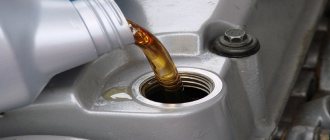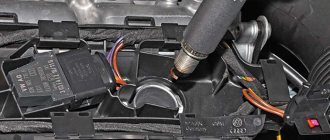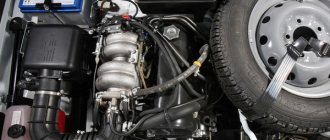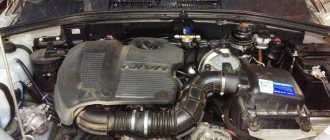Vw polo sedan 1.6 105 hp (cfna)
Let's get down to the drain itself:
- We lift the hood, find the filler neck there, and unscrew the plug (Fig. 1). oil filler neck
- Right there, under the hood, there is an oil filter. It must be unscrewed correctly, since there is a generator underneath it, which should not be filled with oil. Using a puller, loosen the filter, but do not unscrew it completely. Thus, the valve opens and the oil contained in it begins to flow into the pan (Fig. 2). Fig.2 Oil filter
- After 1-2 minutes, put a rag around it, just in case, and unscrew the filter completely. In this case, you should pay attention to the threaded bushing; when unscrewing the oil filter, it can also come out. In this case, screw it back until it stops, by hand (Fig. 3). Fig.3 Threaded bushing
- Now we go down under the car and place a waste container in the drainage area. You can use a cut canister or an old bucket.
- We unscrew the drain plug with a wrench or a socket. On this car, the plug can be 18 or 19 (Fig. 4). Fig.4 Drain plug
- On some engines, the drain plug on the pan is not located at the lowest point, so there is still about 150-250 milliliters of waste remaining in it. To remove them, you can use a rubber bulb or a syringe with a hose attached to it (Fig. 5). Fig.5 Pumping out residues with a syringe
Checking the oil level
Taking into account the fact that even fully serviceable Volkswagen engines can consume oil, the oil level in the engine must be checked every 500 km (for new engines during “break-in”) or 1000 km. mileage
To check the oil level, you need to remove the dipstick while the engine is cool. The level at o is the maximum; topping up is not necessary. Level “B” is the middle (you can add it to level “A”). Level “C” indicates the level is decreasing, which means topping up is necessary.
Let us add that the engines on the Volkswagen Polo have an oil level sensor, which is activated if the lubricant level decreases. However, you should not rely on such a sensor. It is optimal to carry out control using a dipstick to prevent a strong decline and premature wear of the engine.
Vw polo sedan 1.6 110 hp (cwva)
We begin the draining procedure:
- Raise the hood, then find the filler neck on the engine and unscrew the plug (Fig. 6). Fig.6 Oil filler neck
- Now we go down under the car and place a waste container in the drainage area. You can use a cut canister or an old bucket.
- We unscrew the drain plug with a wrench or a 18 or 19 socket, depending on its type (Fig. 7). Fig.7 Drain plug
- Now you need to remove the old oil filter. This can be done from above, from the engine compartment (Fig. 8). Fig.8 Oil filter on top
- The filter is clearly visible from above, but unscrewing it is not so convenient, so we do it from below. Access is very good, nothing interferes (Fig. 9). Fig.9 Oil filter from below
- On this engine the drain plug is also located, not at the lowest point. Therefore, you can use a syringe with a tube. To pump out the remaining waste, as shown in Figure 5.
To unscrew the filter element, it is advisable to have a special puller. If it is not available, you can try to unscrew the filter using improvised means. In this case, you can use, for example, an old alternator belt, a regular belt, a bicycle chain or a simple screwdriver.
Unscrewing the oil filter using improvised means
Using this method, you can drain the maximum amount of used oil, after which you can proceed to further actions. The main thing is not to forget, everything that we unscrewed must be put back in place.
Choosing engine oil for Volkswagen Polo
Given the wide variety of motor oils on the modern automobile market, some people may have difficulty answering the question of which option will be best for their car. In order not to make a mistake in such a situation, it is recommended to adhere to several rules:
- Do not try to profit by purchasing an unknown product at the lowest price. Such savings can initially bring benefits of several hundred rubles, but subsequently cause additional cash costs associated with repair work on the power unit;
- Initially, obtain information about what options are used by people using the same car brand.
To use the second most important rule and find out whether the Volkswagen Polo sedan is more relevant and efficient, it is not at all necessary to identify the owners of such vehicles on city streets, stop them and interview them. You can get all the necessary answers much easier, for example, go to the Internet and look for the necessary information on specialized automobile forums dedicated specifically to this brand of passenger vehicles.
If we analyze the information obtained from such Internet resources, we can note that Volkswagen Polo owners use many types of automobile oils in their vehicles, which work well in a wide variety of conditions. Among the most popular products it is worth noting the following:
- VAG Special Plus 5w40.
- Liqui Moly SYNTHOIL HIGH TECH 5W-40.
- Shell Helix Ultra E.
Unfortunately, not all car enthusiasts have the opportunity to visit large auto stores or markets located in densely populated cities, so they are not always able to buy exactly these products. What to do if there are oils on the counter under not entirely well-known brands, but there is no alternative?
Polo Sedan is a new Volkswagen model, which was created for the conditions of the Russian Federation. A model has been developed based on the Polo hatchback and is equipped with a common platform, which is fully adapted to Russian conditions and is structurally different from the European version in the wheelbase, suspension and body, galvanized in areas susceptible to corrosion. Production of the car began in 2022 in the Kaluga region at the Volkswagen plant.
The model until 2022 had a 1.6-liter naturally aspirated gasoline engine with a power of 105 horsepower, with a five-speed manual transmission or six-speed automatic transmission and front-wheel drive. Modification with 85hp engine. released in 2022, it is subject to tax incentives.
In the same year, a restyled model was offered in a different configuration and with a modified exterior. At the end of 2022, 1.6L E211 engines with 90-110 hp began to be installed on the car. with Euro5 engine oil. The automaker recommends using oils of specifications 504.00 and others.
Factory recommendations
You need to fill in the oil of the brand recommended by the manufacturer.
The manufacturer recommends filling Volkswagen engines with fully synthetic Castrol Edge 5W-40 oil made in Germany.
For Volkswagen Polo, you can use products from various manufacturers that fit the article number. Castrol 5W-40 oil is poured from the factory . Its high-quality composition is maintained in 30-degree frost , a serviceable engine will start without any problems. The product is of high quality and provides an oil film under any load .
Let's take a closer look at viscosity and oil manufacturers below.
Practical subtleties
The selection of oil begins with determining the required viscosity, which is prescribed on absolutely all product containers. Before choosing an oil, you need to understand the nomenclature. The designation on the packaging includes letters and numbers, for example - 5w/40 . The first letter and number is the cold viscosity. They show at what negative temperature the oil will lose its properties:
- -35º – 0w;
- -30º – 5w;
- -25º – 10w;
- -20º – 15w;
- -15º – 20w.
The second number indicates the consistency when heated. The higher the number, the better the viscosity . These designations are suitable for oil marked SAE , it is common and is poured into most cars.
The Volkswagen Polo sedan operating book indicates the recommended oil specification tolerance.
The second important criterion is oil tolerance . It is designated by an alphanumeric article and is assigned to brands after studying the composition. Using it, you can select a product for a specific model, taking into account the operating characteristics of the motor.
Engines Volkswagen Polo sedan 1.6 85, 90, 105 and 110 hp.
What kind of engine oil is poured from the factory (original): Synthetic 5W30 Types of oil (by viscosity): 0W-40, 5W-30, 5W-40 How many liters of oil in the engine (total volume): 3.6 liters. Oil consumption per 1000 km: up to 500 ml. When to change oil: 7000-10000
One of the popular sedans among Russian motorists is the German Volkswagen Polo. The model has been produced and sold in Russia since 2022, having won an army of fans of the products of the VAG automobile concern. The vehicle, at a moderate cost, is an excellent choice for most Russians.
About Volkswagen: Volkswagen Golf dimensions and weight
While cars are serviced under warranty, most of their owners do not wonder what kind of lubricant the official dealer pours into their engine. But when the warranty period ends, you have to make a choice yourself. For many, this is a painful procedure, since the choice of motor oils on the market is huge. How can you select the right products from this variety to narrow your search?
For this purpose, VAG specialists have developed tolerance specifications. Each of the tolerances determines the basic characteristics that the motor fluid must meet in order to properly service engines of the Volkswagen, Skoda, Audi and Seat brands.
In order to obtain a certificate of compliance with a particular approval, the oil fluid is subjected to numerous analyses, trials and tests on Volkswagen gasoline and diesel engines. The process is lengthy and expensive, but for motor oil that has received a certificate, the sales market expands significantly.
According to the service documentation, oils with tolerances 501.01, 502.00, 503.00, 504.00 can be used for gasoline engines of Volkswagen Polo cars. For diesel units, lubricants with VW approval 505.00 and 507.00 are suitable. Until 2022, Volkswagen Polo cars produced at the Kaluga plant were equipped with EA 111 4-cylinder, 16-valve naturally aspirated gasoline engines, developing 85 or 105 horsepower. Now sedans are equipped with upgraded EA 211 power units with slightly more power - 90 and 110 horses.
For these engines, the best choice would be a synthetic oil that has Volkswagen approvals, numbered 502.00 or 504.00. For warranty service of modern engines, dealers use Castrol EDGE Professional LongLife 3 5W-30 and VW LongLife 5W-30. Castrol EDGE is also used on the assembly line of manufacturing plants as a first fill oil.
In addition to the above lubricating compounds, there is a large selection of equally high-quality products. Among them: Mobil 1 ESP Formula 5W-30, Shell Helix Ultra HX 8 5W-30 and 5W-40, LIQUI MOLY Synthoil High Tech 5W-40, Motul 8100 X-cess 5W-40 A3/B4. All these products have received many positive reviews from VW car owners.
List of CFNA modifications
Today on the markets you can find two main modifications of the unit:
- CFNA, developing 105 hp. With.;
- CFNB developing 85 HP. With.
The CFNA accelerates to 100 km/h in 10.5 seconds, the CFNB modification is less fast - in 11.9 seconds. Torque 153 Nm versus 145 Nm. The differences between the versions are also evident in their design - the more powerful modification is equipped with a stepless system for changing the phases of the gas distribution system. The advantage of CFNB over CFNA is that there is less demand for fuel quality - you can safely pour AI-92.
If previously all engines were assembled exclusively in Germany, today this is also done here in Russia. True, at the Kaluga plant the engines are equipped with a timing belt drive, when before they were with a chain.
Tools and materials
Before starting work, you need to buy consumables, including a filter, which is selected depending on the type of engine installed on the Volkswagen Polo:
- The CFNA or CFNB engine, which was installed on the Polo Sedan until the fall of 2022, uses the original oil filter with article number 03С115561D or a newer version 03C115561H. A good alternative part from Mahle Knecht, the article number of which is OC 5933. The oil drain hole is closed with a plug N90813202 with thread size M14 * 1.5 * 22.
- On a more recent CWVA or CWVB engine, a cleaning element 04E115561H is installed. These units use a plug N90288901 with a thread size of M14*1.5*16, equipped with a replaceable gasket N0138157 with a dimension of 14*20 mm. The turbocharged 1.4 liter engine has the same oil filter and cap.
- For the 85-horsepower CLPA engine of the Polo hatchback, filter 030115561AN and plug N90813202 are used. The 105-horsepower unit uses device 03C115561B and plug N90813202 (similar to the CFNA engine). The weakest 75-horsepower engine is equipped with device 03D198819C, cover M14*1.5 N0160276 with ring N0138492. On diesel engines, filters 03P115562 (1.2 liter version) and 03L115562 (for 1.6 liter engine) are used. The drain plug is identical - N90813202.
As a result, you can get started with the following:
- fresh oil in a volume of at least 4 liters;
- new oil filter and drain plug;
- wrenches with sizes 13 and 18 mm.
- torque wrench (if present).
- chain filter puller or gas wrench. Ideally, a cup wrench with a size of 74 or 80 mm is used to remove devices (depending on the type of motor);
- to dismantle the standard protection you will need a screwdriver or a TORX key;
- stable empty container of 4.5-5 liters for draining waste;
- clean funnel for pouring fresh oil;
- rags and a piece of plastic film (a large 200 liter garbage bag will do);
- gloves.
The procedure for filling oil through the oil separator cap is presented in the video from the GARAGE-58 channel.
What kind of oil and how much is needed to change?
Any motor oil for Volkswagen Polo must have approval from the Volkswagen Group and the corresponding designations on the packaging: 501.01; 502.00; 503.00 or 504.00. What do VW approvals mean?
Let's consider the issue of choosing oil in more detail, depending on the year of manufacture of the Volkswagen Polo, starting with cars produced in 2005. For cars from 2005 to 2022 (inclusive), you can choose “synthetics” or “semi-synthetics”. For vehicles manufactured starting from 2022, only synthetic oils should be selected.
Motor oils for gasoline vehicles:
- released in 2005 must have an API category - SL,
- released in 2006 - 2022, must have the API category - SM,
- released from 2022 to 2022 (inclusive) must have the API category - SN.
For vehicles with diesel engine:
- released in 2005-2021, the oil must have an API - CI category,
- released in 2021-2021, the oil must have an API category - CJ,
- released from 2022 to 2022 (inclusive), API – CJ-4.
How to choose engine oil for winter?
- For cars manufactured from 2005 to 2022 (inclusive), winter oils with parameters 0W-40 and 5W-40 are suitable. For cars released in 2022, you can still use 5W-50.
- For cars from 2022 to 2022 (inclusive), 0W-40 and 0W-50 oils are suitable.
- For Volkswagen Polo released in 2022 - 0W-50 oils.
- For those released in 2022 - oils 0W-50 and 0W-60.
How to choose motor oil for summer?
- For cars manufactured from 2005 to 2022 (inclusive), summer oils with parameters 20W-40 and 25W-40 are suitable. For cars released in 2022, another 25W-50 is added.
- For cars from 2022 to 2022 (inclusive), 20W-40 and 25W-50 oils are suitable.
- For those released in 2022 - oils 15W-50 and 20W-50.
- For those released in 2022 - oils 15W-50 and 15W-60.
About Volkswagen: How many liters are in the cooling system of a Volkswagen engine
How to choose all-season oil?
- For cars manufactured from 2005 to 2022 (inclusive), all-season oils with the following parameters are suitable: 10W-40, 5W-40, 15W-40. For cars released in 2022, another 10W-50 is added to those listed.
- For cars manufactured from 2022 to 2022 (inclusive), oils with the following parameters are suitable: 10W-50, 5W-40, 15W-40.
- For Volkswagen Polo released in 2022 - 5W-50 and 10W-50 oils.
- For those released in 2022 - 5W-50 and 10W-60 oils.
In addition to original oils from Volkswagen, for replacement, you can choose other options that will suit your car’s engine just as well if they are correctly selected in terms of viscosity - these are products from Mobil, Shell and Castrol. Now, to the question: how much oil to pour?
When changing the oil and, at the same time, the oil filter, you need to fill the Volkswagen Polo (1.6) with 3.5 liters.
How to choose an analogue
The choice of oil change for Volkswagen Polo is made in accordance with the requirements of the plant.
VAG Specifications
For car models manufactured before 2001, the company recommends using VW 500.00 mixtures. Due to the obsolescence of the standard, it is allowed to use more recent certificates or a group of oils that comply with ACEA A1 / B1. Factory approval applies to naturally aspirated engines without aftertreatment systems.
Polo cars produced after this period (2010-2015 and later) must be filled with such mixtures.
- 501.01 - support for power plants with direct fuel injection, regardless of the fuel consumed.
- 502.00 is a more complex version of the first standard. ACEA A3/B3 compliant.
- 503.00 - works where light turbines are installed and there are no particulate filters. Improved compatibility with extended service intervals.
- 504.00 - the standard is relevant for all power plants with exhaust gas treatment systems, a turbocharger or direct injection. The duration of one section is 30,000 km.
The basis
The Volkswagen Polo uses all three types of lubricants available in 2022.
Mineralka
Operation is relevant for Volkswagen Polo cars manufactured before 2000. Lubrication is produced by processing sulfur oil. It has minimal protective properties and a moderate service life. The advantage is the affordable cost.
Semi-synthetics
The adapter link is mainly used in all generations of engines. Old Volkswagen Polo internal combustion engines can be refilled in any conditions. New engines allow you to fill half of the artificial fluid only with high mileage.
As for the protective properties, all parameters are at an average level.
Synthetics
Advanced engineering. Oil is produced using natural gas synthesis technology to produce complex hydrocarbons. This guarantees the absence of harmful impurities and, as a result, excellent protection of internal components from premature wear.
The mixtures are bottled in new Volkswagen Polo cars.
Viscosity
When it comes to lubricant fluidity, Polo engines are not fussy. Viscosity is determined by the climatic conditions in which the machine is used individually. The SAE J300 standard temperature chart is used as a reference tolerance.
Amount of oils and fluids volkswagen polo | car breakdowns
Volkswagen Polo is a legendary car. For forty years, five generations of the brand have been delighting its owners with reliable and high-quality service, making life more comfortable and beautiful. But this merit is not only of the manufacturer; the role of the drivers is also great. They carry out maintenance in a timely manner, which has a positive effect on its performance.
Replacing consumables
During the operation of the machine, consumables age and lose their properties, so they need to be replaced. For Volkswagen Polo, the manufacturer recommends that it be carried out once a year or when the mileage is 15 thousand km.
In practice, these periods can be reduced to 10 thousand km. Especially in cases where the car is often stuck in traffic jams and idling. Since the lubricant quickly becomes unusable.
Experts recommend
Below is a table containing all the information that relates to this issue. It specifies parts, systems, quantities and features of consumables.
| Filling/lubrication point | Filling volume, liters | Name of oil/liquid | |||
| Fuel tank | 55 | AI-92 AI-95 | |||
| Engine | Volume 1.6 l | 105 hp | 3,6 | API SL (ILSAC GF-III) VW 502 000 | |
| 86 hp | 4 | ||||
| 110 hp | 3,6 | ||||
| Volume 1.4 l | 3,2 | SAE10W-30 Low temperature areas: SAE 5W-30 | |||
| Cooling system | 5,9 | Antifreeze G12 (G12 G12) with distilled water | |||
| Transmission | Automatic transmission | 7 | Gearbox VW TL 162 | ||
| Manual transmission | Engine 1.6 l | 2,1 | Gearbox VW TL 501 50 (GL-4), SAE75W-85 | ||
| Engine 1.4 l | 1,8 | SAE 80W at low temperatures SAE 75W | |||
| Brake system | 0,5 | DOT 3 or DOT 4 | |||
| Power steering fluid | 1,1 | DEXRON II-D or DEXRON III | |||
PS: Dear car enthusiasts, if you have your own information on this topic, please tell us about it in the comments or write an email to the site administration.
Engine oil volume for replacement in a 1.6 mpi cwva ea211 engine
Hello, readers of my magazine!
I continue the series of articles devoted to the operation of the Volkswagen Polo Sedan and today, in my opinion, there will be a very interesting topic for discussion - how much engine oil should be poured into the CWVA EA211 engine.
The fact is that in the latest restyling of the car, the power plant was changed and the CFNA was replaced by 105 hp. the CWVA EA211 engine with 110 hp arrived. And when I was just starting to study this issue, on many automobile websites I came across information that the filling volume of the CWVA engine is also 3.6 liters of engine oil. This information is wrong!
To resolve this issue, I contacted the Volkswagen Group Rus hotline. And this is what they wrote to me in response (I quote verbatim the response from the support technician):
The filling volume of engine oil for the engine of your Volswagen Polo Sedan is 4 liters, if necessary, after a complete replacement, bring it to the “maximum” level. Information on the operating level of the engine oil is reflected in the operating manual in the “Care, cleaning, maintenance” section, chapter “Engine oil”.
I would like to comment a little on this answer.
Experimentally, I found that when pouring 4 liters of engine oil into the CWVA EA211 engine, the level will be slightly above the middle of the grooved area of the engine oil dipstick. See what it looks like in the photo below.
In order to fill the grooved area of the dipstick (from the minimum to the maximum point), a liter of engine oil is required.
Thus, in order for the engine oil level in the engine to reach the maximum (reach the highest point of the grooved area of the dipstick), we need to fill in 4.3 liters of engine oil.
For those who like to watch video format, I offer you the corresponding release
However, I would like to note that you need to add engine oil in 100 ml portions and after each fill, check the engine oil level, having first positioned the car on a horizontal surface without a slope.
Regulations
To choose the right oil, you need to act step by step and observe all important parameters, including performance indicators. For example, you need to know when to replace consumables. For this, the manufacturer has developed a replacement schedule, which for the VW Polo Sedan is about 20 thousand kilometers.
This is a conditional indicator that can be changed at the insistence of the dealership, or on the initiative of the owner himself (with self-service). In the latter case, changing the oil is much more difficult, but it is a very educational and economical procedure that does not take much time. It will have to be carried out as often as possible if the machine is operated in unstable climatic zones and is subjected to high loads.
After all, under the influence of negative factors, the oil must be changed in advance so that it does not have time to lose its properties. Due to difficult conditions, the regulations can be reduced to 10 thousand kilometers. In addition, rapid oil wear is affected by high speed, driving on light off-road conditions, including dusty roads, constant temperature changes, sudden maneuvers and even traffic violations.
In such cases, you must be prepared to change the oil earlier than required by the regulations. But for this it is important to know several factors.
[custom_ads_shortcode3]
Installing a filter, filling in new engine fluid
If the lubrication system of the Volkswagen Polo Sedan is sealed and does not require repair work to eliminate leaks, you can proceed to adding fresh engine oil. In addition to the oil itself, to replace it we need a new drain plug, as well as an oil filter. This is what the instruction manual says.
Therefore, for the 1.6 105 hp engine (CFNA) we purchase a bolt with VAG part number N 908 132 02 (N90813202). This bolt already comes with a sealing washer and is designed specifically for use on aluminum pallets. The original oil filter comes with the VAG part number 03C 115 561 H (03C115561H).
About Volkswagen: Engine oil volume of Volkswagen Golf, 6th generation (MK6), 2008-2013
Consumables for 1.6 105 hp (CFNA)
For a 110 hp engine (CWVA), you need a bolt VAG N 902 889 01 (N90288901), as well as a gasket-washer for it, the original one is white VAG N 013 81 57 (N0138157). The filter has an article number that is VAG 04E 115 561H (04E115561H).
Consumables for 1.6 110 hp (CWVA)
When everything is ready, let's move on to the bay:
- Replace the drain plug and replace it with a new one if necessary.
- We wipe the seat under the oil filter.
- We twist it and put it in place. Pre-lubricate the rubber sealing ring with fresh oil.
- Pour new oil into the filler neck.
- We check the level on the dipstick; it should be between the MIN and MAX marks.
- We start the engine, let it run for 10-15 seconds, then turn it off.
- After 5 minutes, check the level with a dipstick and top up if necessary.
There are several opinions regarding replacing the oil filter. Some car owners advise filling it with new oil before installation. However, in the official instruction manual for the Volkswagen Polo. And also in information from well-known filter manufacturers, it is recommended to simply lubricate the O-ring.
When to check the oil condition
Many people check the condition of the oil according to regulations. In fact, it is better to do this earlier, without waiting for the regulations. The following signs indicate problems with oil:
- Insufficient engine power
- Increased fuel consumption
- Increased oil consumption
- Possible delays and jerks when changing gears
- Excessive noise and vibration levels
If these deviations are detected, it would be a good idea to check the condition of the oil.
Volkswagen polo sedan engine, technical characteristics of volkswagen polo engines
The Volkswagen Polo sedan engine, which we will talk about today, will be produced directly in Russia in 2022, at the new Volkswagen engine plant. True, the timing chain will be replaced with a belt, and the power of the unit will increase by 5 horsepower.
In addition to the Polo sedan, a 1.6-liter gasoline engine is now installed in the larger Jetta, Skoda Octavia and Rapid models. The 1.6-liter power unit, the most popular among our customers, is produced in two versions with a capacity of 85 and 105 hp.
with 16 valves (factory designation CFNB and CFNA, respectively). The difference between the 85 horsepower version and the 105 horsepower modification of the Volkswagen Polo engine lies in the design features of the cylinder head and the presence (or absence) of a variable valve timing system.
Naturally, due to the presence of a timing system, the 105 strong version is more powerful, dynamic and economical. First, let's talk about the more powerful Polo sedan engine. So, the Polo 1.6 16V engine has the factory name CFNA. It is a gasoline, four-stroke, 4-cylinder, in-line, 16-valve, two-camshaft engine. Under the hood it stands transversely. The operating order of the cylinders is: 1-3-4-2, counting from the crankshaft pulley.
The engine power supply system of the Volkswagen Polo sedan is phased distributed fuel injection. The engine is mounted on three elastic rubber-metal supports.
The right support is hydraulic; it is attached to a bracket attached to the timing cover, and the left and rear engine mounts are attached to brackets on the gearbox housing. The Volkswagen Polo engine cylinder block is aluminum, the cylinder head is also aluminum, and the engine sump is also made made of aluminum alloy.
In the 16-valve version, the spark plugs are screwed into the top center of the combustion chamber. Timing chain drive. The chain in the engine makes the Polo sedan 1.6 unit very reliable and durable. In addition, the cylinder head contains hydraulic compensators that automatically regulate the thermal clearance of the valves. The engine is very sensitive to oil quality.
Underfilling of oil and its reduced level can lead to rapid wear of the hydraulic compensators.
The Polo sedan 1.6 engine has a system of continuously variable valve timing of the intake valves, which makes the engine flexible in all operating ranges. The engine has a contactless ignition system with four coils. The entire operation of the power unit is controlled by an electronic control unit (the brains of the motor).
An electronic system controls fuel distribution. The dosed working mixture is supplied to the cylinders through the throttle assembly in accordance with the valve timing. Below are detailed characteristics of the Volkswagen Polo 1.6 16V CFNA engine.
CFNA Fault Overview
The manufacturer insists - regularly monitor the amount of lubricant, and the engine will not cause serious problems during operation! In addition, when driving in the summer with a half-empty tank, the fuel pump is under heavy load. It may fail unexpectedly. Signs of a dying fuel pump: A strong, buzzing sound. Replacing the pump filter element can only temporarily correct this problem. In the future, only replacement will help.
The main malfunction of the presented power unit is associated with knocking or diesel noise - a familiar problem to almost all owners of the Polo Sedan. The engine literally rumbles, especially when cold. The reason lies in the special shape of the CFNA pistons and the outdated design of the exhaust manifold. There are two ways to fix this problem:
- complete replacement of pistons and VK with simultaneous reprogramming of the ECU;
- installing ET pistons instead of standard ones.
The first option will not only eliminate the knocking problem, but will also make it possible to modernize the engine. The second method is more suitable for new motors that are still under warranty. You can order such work from a dealer if the noise level is really annoying.
CFNA knocks also occur when driving on uneven road surfaces. As a rule, this is due to a weakening of the engine mount - most often the left mount. It cannot withstand loads and quickly collapses.
Another malfunction, again related to the exhaust manifold. Over time, cracks appear on it. Signs of a broken VC will be the changed sounds of the internal combustion engine during operation. As in the first case, the problem can be completely solved by replacing the standard collector with a more modern “spider” type. If you don’t want to change the intake, you can try welding the block using argon welding.
In addition to oil, it is also recommended to fill in high-quality fuel - gasoline for CFNA must have an octane rating of at least AI-95! This will be a guarantee against instability of speed, jerks and jolts. In addition, the piston group of this engine is coated with graphite. This protective layer wears off quickly when using low-grade gasoline. Scores appear on the inner walls of the cylinders. You should also not allow the engine to overheat frequently, realizing that a lack of oil will immediately lead to the destruction of the connecting rod bearings.
Engine characteristics cfna/cfnb/cwva/cwvb
| Production | Chemnitz engine plant Kaluga plant |
| Engine make | CFNA/CFNB/CWVA/CWVB |
| Years of manufacture | 2021-present |
| Cylinder block material | aluminum |
| Supply system | injector |
| Type | in-line |
| Number of cylinders | 4 |
| Valves per cylinder | 4 |
| Piston stroke, mm | 86.9 |
| Cylinder diameter, mm | 76.5 |
| Compression ratio | 10.5 |
| Engine capacity, cc | 1598 |
| Engine power, hp/rpm | 85/5200 90/5200 105/5250 110/5800 |
| Torque, Nm/rpm | 145/3750 155/3800-4000 153/3800 155/3800-4000 |
| Maximum speed, rpm | 6000 |
| Fuel | 95-98 |
| Environmental standards | Euro 5 |
| Engine weight, kg | — |
| Fuel consumption, l/100 km (for Polo Sedan CFNA) - city - highway - mixed. | 8.75.1 6.4 |
| Oil consumption, g/1000 km | up to 500 |
| Engine oil | 0W-40 5W-30 5W-40 |
| How much oil is in the engine, l | 3.6 |
| Oil change carried out, km | 7000-10000 |
| Engine operating temperature, degrees. | 85-90 |
| Engine life, thousand km - according to the plant - in practice | — 200 |
| Tuning, hp — potential — without loss of resource | 150 n.d. |
| The engine was installed | VW Polo Sedan VW Jetta Skoda Fabia Skoda Octavia Skoda RapidSkoda YetiSkoda Roomster |
| Gearbox - 5 manual transmission - 6 automatic transmission | VAG 02T Aisin 09G |
| Gear ratios, 5 manual transmission | 1 — 3.46 2 — 1.96 3 — 1.28 4 — 0.88 5 — 0.67 |
| Gear ratios, 6 automatic transmission | 1 — 4.148 2 — 2.37 3 — 1.556 4 — 1.155 5 — 0.859 6 — 0.686 |
CFNA tuning options
This engine has potential. Initially, there is a certain reserve of power that can be intelligently deployed. As mentioned above, the pistons and exhaust manifold of this unit are outdated. It is advisable to replace or remake them:
- VC needs to use a 4-2-1 or 4-1 bescatless;
- Install a modern cold air intake system;
- Reflash the ECU.
This will increase the power of the unit to 130 horses, without significantly reducing the resource.
The Spider 4-1 rollless exhaust manifold will increase engine power several times











